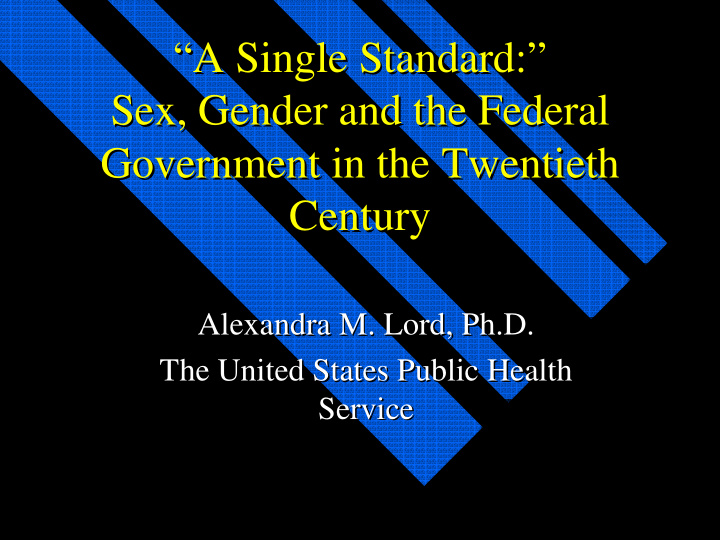



“A Single Standard:” A Single Standard:” “ Sex, Gender and the Federal Sex, Gender and the Federal Government in the Twentieth Government in the Twentieth Century Century Alexandra M. Lord, Ph.D. Alexandra M. Lord, Ph.D. The United States Public Health The United States Public Health Service Service
Public Perceptions of STDs Public Perceptions of STDs during the Nineteenth and Early during the Nineteenth and Early Twentieth Centuries Twentieth Centuries n Evidence of moral corruption and “a crisis n Evidence of moral corruption and “a crisis in the family” in the family” n Punishment for “sexual irresponsibility” n Punishment for “sexual irresponsibility” n Americans can be educated to avoid STDs n Americans can be educated to avoid STDs by practicing abstinence (or continence) by practicing abstinence (or continence)
Gender and Perceptions of Gender and Perceptions of Sexuality Sexuality n Women as n Women as “passionless” “passionless” n Female sexuality n Female sexuality exercised only within exercised only within the framework of the framework of marriage and only for marriage and only for reproductive purposes reproductive purposes
Rising Concerns About STDs in Rising Concerns About STDs in the Early Twentieth Century the Early Twentieth Century n Development of the Wasserman Test (1906) n Development of the Wasserman Test (1906) n Development of Salvarsan (1909) n Development of Salvarsan (1909) n World War I increased concerns regarding men’s n World War I increased concerns regarding men’s health and sexuality health and sexuality n Eugenics Movement increased concerns regarding n Eugenics Movement increased concerns regarding women’s health and sexuality women’s health and sexuality
Limited Understanding of Limited Understanding of Sexually Transmitted Diseases Sexually Transmitted Diseases among Americans among Americans n Most young men n Most young men believe that STDs can believe that STDs can be quickly and easily be quickly and easily cured cured n Most young women Most young women n have no knowledge of have no knowledge of STDs or their method STDs or their method of transmission of transmission
Sexual Revolution of the 1920s Sexual Revolution of the 1920s n Women no longer n Women no longer seen as “passionless” seen as “passionless” n Greater acceptance of n Greater acceptance of sexual intercourse sexual intercourse outside of the outside of the constraints of marriage constraints of marriage
Government Response to the Government Response to the Sexual Revolution of the 1920s Sexual Revolution of the 1920s n Call for “return to traditional values” n Call for “return to traditional values” n Use of traditional female images (“the good n Use of traditional female images (“the good woman” and “the fallen woman”) in government woman” and “the fallen woman”) in government pamphlets pamphlets
Reasons for the use of traditional Reasons for the use of traditional images of women images of women n Provides women with clearly demarcated n Provides women with clearly demarcated role models which they should follow in a role models which they should follow in a period when women’s roles were in flux period when women’s roles were in flux n Simplicity of message n Simplicity of message
Images of Men in Government Images of Men in Government Sex Education Campaign Sex Education Campaign n “ n “Real” men do not Real” men do not have sex outside of have sex outside of marriage marriage n “Real” men practice n “Real” men practice abstinence abstinence
World War II Causes a Shift in World War II Causes a Shift in the Government’s Approach to the Government’s Approach to STDs STDs n Men, especially those n Men, especially those in the military, may in the military, may have multiple sex have multiple sex partners partners n Men should be Men should be n provided with provided with protection protection
Images of Women Images of Women n Women are either n Women are either “good” (sexually pure “good” (sexually pure and therefore free of and therefore free of venereal disease) or venereal disease) or “fallen” (suffering “fallen” (suffering from venereal disease) from venereal disease) n No information n No information regarding prophylaxis regarding prophylaxis is to be made available is to be made available to women to women
STDs dramatically decline during STDs dramatically decline during World War II only to rise again World War II only to rise again in the 1960s and 1970s in the 1960s and 1970s
The Emergence of AIDS during The Emergence of AIDS during the 1980s the 1980s or or Does History Repeat Itself? Does History Repeat Itself?
Recommend
More recommend